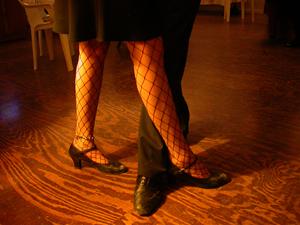
Tangophilia
Eager couples gathered at Helios Coffee Company in downtown Raleigh on Saturday for the opportunity to embrace the world of Argentine Tango. Dimmed lights and sultry music made Helios an intoxicating delight. While some might find the idea of learning a foreign dance among strangers intimidating, the ease and enthusiasm of the instructor helped put all those qualms aside.
The atmosphere was open and non threatening. The group was not so large that the couples did not receive the proper attention, but not too small as to feel uncomfortable.
On this particular night there were approximately 14 couples at the beginning of the session, most of whom who appeared in their mid-to-late 20s. This particular event was a milonga, also known as a social dance. The students were first given introductory Tango lessons and afterward there was social dance, where couples could practice there new skills on the dance floor.
Tangophilia hosts many events throughout the year and at many different locations. However, according to Jason Maynard, a horticulture alumnus and devoted attendee of Tangophilia events, “Helios is always the largest venue.”
The company hosts milongas that are open to the general public, and every third Saturday of the month, the event is held at Helios. Typically, a milonga lasts anywhere from four to six hours. The cover charge is $7 and includes both the lesson and a free alcoholic or non-alcoholic beverage. For those on an even tighter budget, every first Thursday of the month dancing sessions are free at April & George Gallery and Wine Bar. This venue is located almost directly across the street from Helios Coffee.
Ryan Laughlin and Gulden Ozen started and presently run the Tangophilia. Heloisa Portela Myers, a Tangophilia instructor and doctorate student in counselor education explains the dance was responsible for bringing the couple together.
While the company has expanded to Nashville, Tenn., and other parts of the state, she said, “[Tangophilia] is a triangle organization. It’s more of a regional thing.”
The Tangophilian philosophy is that Argentine Tango is a form of communication and that learning to Tango is similar to learning a different language. Instead of focusing on memorizing steps, Tangophilia teaches the methods and how to better connect with your dance partner.
“[Dancing Tango] is like learning a new language,” Myers said. “The Tango is about learning the language — learning how to speak it.”
Keith Linder, a professor at the Veterinary School and instructor at the Helios Tangophilia session on Saturday, explained he first encountered Tangophilia by coming into one of the Helios Coffee milongas one night and inquired about the event. He got involved with Tangophilia shortly after that experience.
“[Tangophilia] is a strong cultural connection that supports diversity,” Linder said. “Here’s a whole social mix of people.”
He explained college students, professors, doctors and the rest of the public participate in these events. In his opinion, Tangophilia is a great way for students to learn about the dance and culture of Tango.
When explaining why he chose to take part in Tangophilia, Maynard said, “I participated in Dancing with Wolves and Tango was my favorite, so I decided to try out Argentine Tango. [Tangophilia] is a very active group; they do a lot of things.”
Tangophilia instructs its students with Argentine Tango as opposed to Ballroom Tango. Ballroom is the more popular of the two, but Tangophilia has a different philosophy. It focuses on having students dance their own steps as opposed to Ballroom, which emphasizes memorization.
Myers said, “The reason I’m involved [with Tangophilia] is because I love Tango. I’m very passionate about it. Some say it’s like a bug — once you’re bitten, you’ve got the Tango bug.”
Tangophilia also recruits Argentine dancers to come and help teach the events. They have had many popular Tango dancers come to their workshops, practices and milongas. In addition, Tangophilia offers classes and private lessons.
“They organize events very well,” Myers explained. “Their system of teaching is understanding the language of Tango. They are very passionate about it.”
Fabian Salas, who is famous in the world of Tango, even came in December to teach three to four days of workshops. Other instructors come from other places such as Holland, Buenos Aires and Germany.
“I want to say come on over,” Myers said. “[Tangophilia] is great because it is artistic and fun. You can learn to speak the language as long as you have the motivation.”
She said taking part in Tango is good for her mental health. Those few minutes of dancing are an escape from her daily worries and she allows herself to become absorbed in the dancing.
“Don’t feel like you can’t do it,” Myers said. “Really, in Tango, anybody can learn it.”
She explained milongas are great for first-timers because they offer an introductory lesson at the beginning of the session to introduce the newcomers to the techniques of Tango.
“[The first-timers] are in the same boat you are in,” Myers said. “[Milongas] give them the sense of things to do in the dance.”
For more information about Tangophilia, go to their website at www.tangophilia.com.
Also, Linder and Myers have started their own the Argentinean Dance Club at N.C. State, which is open to students and faculty alike. To get on their listserv, send an e-mail to ncsutango@gmail.com.